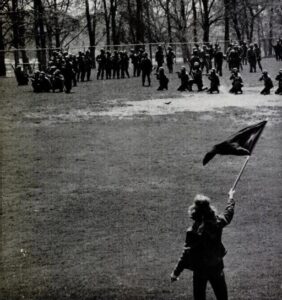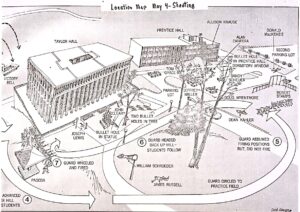 The Vietnam War was a volatile time in American history. When the war started, so did the draft. Many people protested, especially students. I suppose for them, it all felt so much closer to home, than for the older Americans. Still, the students were not alone in protesting. Many Americans agreed and protested too. The law allows for “peaceful” protesting, saying that it is “a constitutionally protected form of expression under the First Amendment in the United States. It falls under the right to free assembly, allowing every American to voice their opinions and advocate for change. However, a protest becomes a riot when one or more people within the group engage in criminal activity. This can include intentionally damaging property or causing physical harm to another person1. In other words, when a peaceful demonstration loses control and turns violent, it transitions from a protest to a riot.”
The Vietnam War was a volatile time in American history. When the war started, so did the draft. Many people protested, especially students. I suppose for them, it all felt so much closer to home, than for the older Americans. Still, the students were not alone in protesting. Many Americans agreed and protested too. The law allows for “peaceful” protesting, saying that it is “a constitutionally protected form of expression under the First Amendment in the United States. It falls under the right to free assembly, allowing every American to voice their opinions and advocate for change. However, a protest becomes a riot when one or more people within the group engage in criminal activity. This can include intentionally damaging property or causing physical harm to another person1. In other words, when a peaceful demonstration loses control and turns violent, it transitions from a protest to a riot.”
On May 2, 1970, a protest rally at Kent State University resulted in the National Guard troops being called out to suppress students who were now rioting in protest of the Vietnam War and the US invasion of Cambodia. As scattered protests continued the next day, they were dispersed by tear gas, and on May 4th class resumed at Kent State University. University officials put a ban of rallies, but it didn’t stop the rallies. By noon, some 2,000 people had assembled on the campus. The National Guard troops arrived and ordered the crowd to disperse, fired tear gas, and advanced against the students with bayonets fixed on their rifles. As is common among protesters, some refused to disperse, and even responded by throwing rocks and verbally taunting the troops.
As the situation escalated, and without firing a warning shot, 28 Guardsmen discharged more than 60 rounds  toward a group of demonstrators in a nearby parking lot, killing four and wounding nine, one of whom would be permanently paralyzed. The closest casualty was 20 yards away, and the farthest was almost 250 yards away. After a period of disbelief, shock, and attempts at first aid, angry students gathered on a nearby slope and were again ordered to move by the Guardsmen. Though they were prepared to stand and even die for their beliefs, faculty members were able to convince the group to disperse, and further bloodshed was prevented. The Kent State campus was closed for six weeks following the tragedy.
toward a group of demonstrators in a nearby parking lot, killing four and wounding nine, one of whom would be permanently paralyzed. The closest casualty was 20 yards away, and the farthest was almost 250 yards away. After a period of disbelief, shock, and attempts at first aid, angry students gathered on a nearby slope and were again ordered to move by the Guardsmen. Though they were prepared to stand and even die for their beliefs, faculty members were able to convince the group to disperse, and further bloodshed was prevented. The Kent State campus was closed for six weeks following the tragedy.
News of the shootings reverberated across the globe. It also led to protests on college campuses across the country. Just five days after the shootings, 100,000 people demonstrated in Washington, DC, both against the war and the killing of unarmed student protesters. The media put out photographs of the massacre, and the images became enduring images of the anti-war movement. A criminal investigation followed, and in 1974, at the end of the investigation, a federal court dropped all charges levied against eight Ohio National Guardsmen for their role in the Kent State students’ deaths. The decision was followed by outrage.
After the decision was made, the defendants issued a statement, “In retrospect, the tragedy of May 4, 1970, should not have occurred. The students may have believed that they were right in continuing their mass protest in response to the Cambodian invasion, even though this protest followed the posting and reading by the university of an order to ban rallies and an order to disperse. These orders have since been determined by the Sixth Circuit Court of Appeals to have been lawful.
Some of the Guardsmen on Blanket Hill, fearful and anxious from prior events, may have believed in their own  minds that their lives were in danger. Hindsight suggests that another method would have resolved the confrontation. Better ways must be found to deal with such a confrontation.
minds that their lives were in danger. Hindsight suggests that another method would have resolved the confrontation. Better ways must be found to deal with such a confrontation.
We devoutly wish that a means had been found to avoid the May 4th events culminating in the Guard shootings and the irreversible deaths and injuries. We deeply regret those events and are profoundly saddened by the deaths of four students and the wounding of nine others which resulted. We hope that the agreement to end the litigation will help to assuage the tragic memories regarding that sad day.” I agree, better ways must be found by both the protesters and the authorities.


Leave a Reply